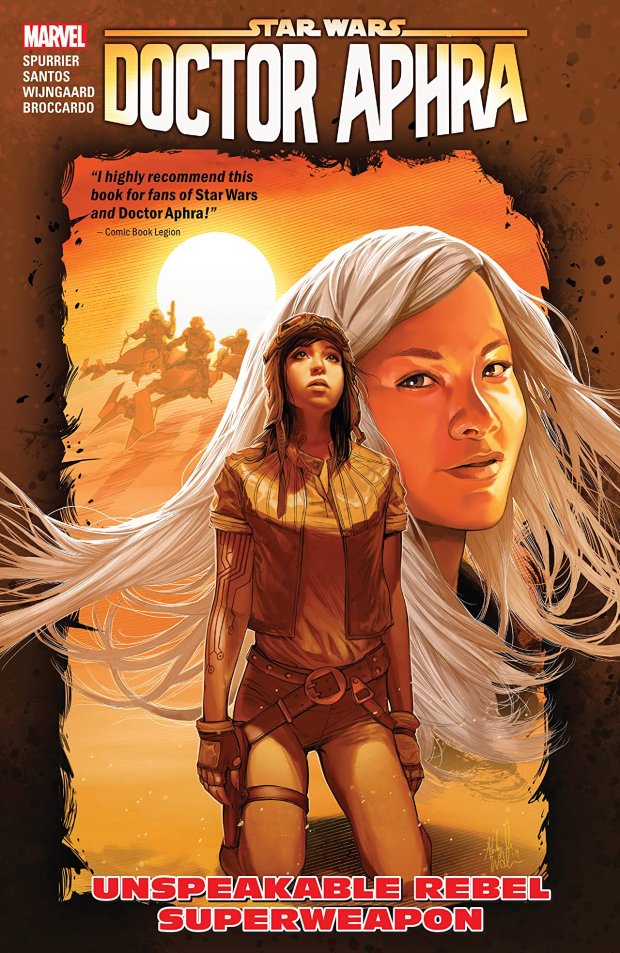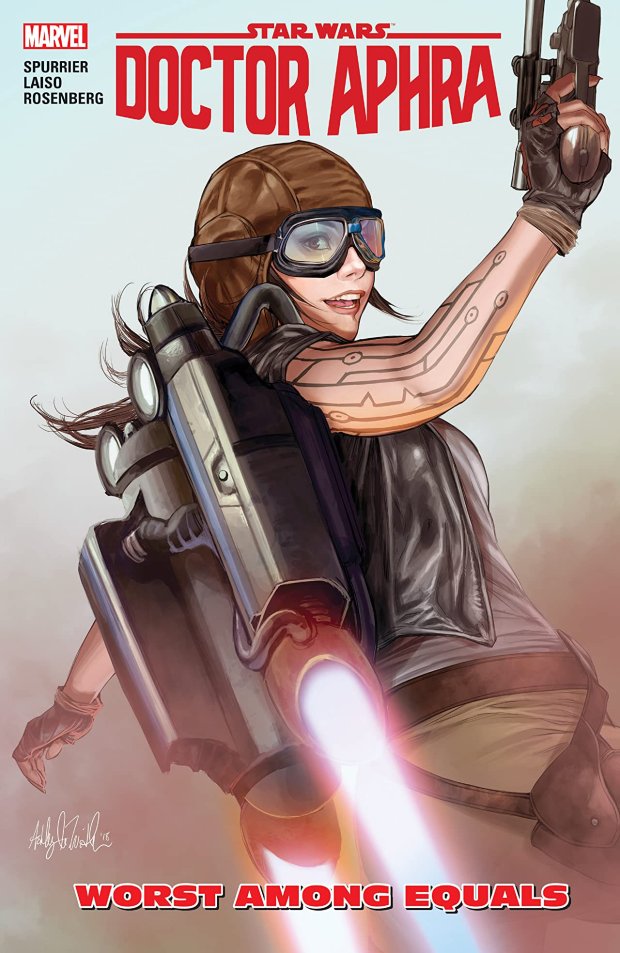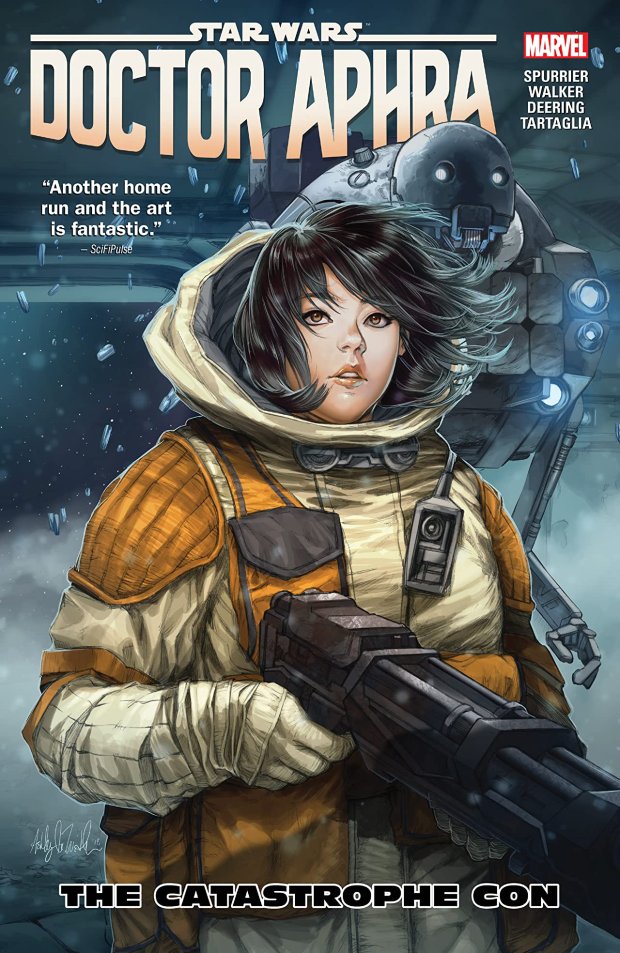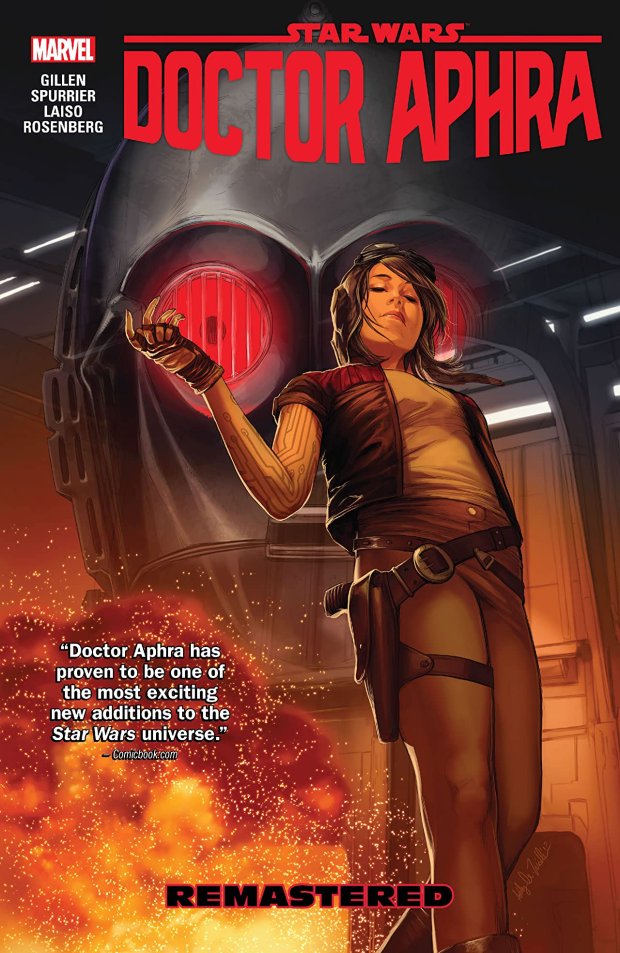by Simon Spurrier, Kev Walker, Marc Deering, Java Tartaglia, Joe Caramagna
collects Doctor Aphra #20-25
volume one | two | three | four | five | six| seven [complete]
Doctor Aphra has a lot of momentum going for her, but volume four really stumbled. But there’s still a lot of good, and maybe the fact that it took until volume four is a good thing.
Catastrophe Con drags in the first three issues, but there are enough twists and changing allegiances to keep things engaging. That’s largely thanks to Aphra herself, and Simon Spurrier (taking over full time as writer from Kieron Gillen) does a nice job having a firm handle on her character (and her vague morality) alongside a large cast with their own contradicting agendas and priorities. I also really appreciate how Aphra’s series leans into the wackiness of the Star Wars universe, including a space jail, mind reading and shape shifting aliens, and Jedi ghost spores.
It’s worth celebrating that we have three queer women who show up in this volume – Aphra, Tolvan and Sana – probably a first for the Star Wars universe. It’s amazing to see Star Wars becoming more diverse, and that it’s not diversity for its own sake (hopefully) – Aphra and Tolvan are full characters beyond just their sexuality, which is a huge win. (More on Sana below.)
But the writing was still flawed, and that’s even more frustrating because this is so rare, and because straight couples are treated so differently. First of all, Tolvan and Aphra’s romance is completely rushed. Last volume they had a one night stand; now, the next time they meet, Tolvan declares her love out loud? I’m not buying it – there just wasn’t enough time, along with Tolvan’s disciplined personality, for it to make sense. Plus, Sana was clearly shoehorned into the issue to create drama and not much else – this is the second time she’s been brought in to stir up tension in a couple, which sucks. Plus, her monologue at the beginning (indicating she is far from over Aphra), and their conversation later, was a complete mismatch.
It’s frustrating that Star Wars is happy to have Han and Leia banter with sexual tension for eons, but Tolvan and Aphra can’t even stay in one stage of a relationship for more than one or two issues. Spurrier has a so many moving parts in this issue (perhaps one too many), that Aphra and Tolvan can’t really be at the center of it – it needs to be rushed through to get to the next thing – and that’s where this loses me. Star Wars comics, I am perfectly happy *not* seeing the Big Bad Villain or Space Explosion every single arc. You’re allowed to let your characters breathe. Especially if it means doing a queer romance justice, which your universe has literally never done before.
That being said, Spurrier does a fantastic job slowly forcing Aphra into a corner, decisions and betrayals building on each other for a dark but satisfying resolution. I didn’t always like how she was drawn (more on that below), but Spurrier is very solid on her character, ambiguous morality, and her humor. And like Gillen before him, Spurrier ensures that Aphra is in a very different place than the last volume and there are real consequences to her actions. It’s so different than the main Star Wars title – Luke, Leia and the others are so safe, their stories lack urgency and real character development. With Aphra and her corner of the galaxy, there’s no safety net, and therefore a whole lot of room for more interesting storytelling. However, sometimes the wacky elements of the story were either a bit far fetched (the mind altering alien) or resolved too quickly with exposition (the Jedi ghost).
Art team Kev Walker and Marc Deering return from the second volume, with Java Tartaglia on colors. I had a real love-hate relationship with the art, and most of the way through, it was the latter. The precision of the spaceships, buildings and aliens feel very true to Star Wars, but it just didn’t translate to humans, whose proportions weren’t consistent (Aphra’s doe eyes especially), and whose expressions lacked the force of emotion to really drive home pivotal scenes. Tolvan shouting for Aphra to respond while trying to escape, and Sana and Aphra talking about their breakup – these emotional moments fell flat. I’m a much bigger fan of volume two’s art team, Laiso and Rosenberg.
**spoilers, maybe?** And then, I’m hit with a full page of Triple Zero walking through fire, singing an upside down musical note, towards a terrified Aphra and Tolvan, and it might be one of my all-time favorite pages in comics. Frankly, I wish Aphra herself got the same precise attention and “wow” moment. Holding a light saber in tears doesn’t really cut it for me.
I’m still enjoying the series – Aphra as a character is compelling enough to get me through the “meh” volumes. But every volume I can’t help but notice the creative team is an all-boys club, and while one’s identities certainly don’t have to match the characters you’re creating, it still bothers me (especially contrasted with three queer women in this one volume). It will probably bother me until I get to the new series and I’ll mention it every time – but that’s because for every volume, it really was a choice.




